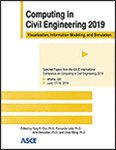ASCE International Conference on Computing in Civil Engineering 2019
Understanding Roofer’s Risk Compensatory Behavior through Passive Haptics Mixed-Reality System
Publication: Computing in Civil Engineering 2019: Visualization, Information Modeling, and Simulation
ABSTRACT
Despite substantial efforts to address fall prevention and curb the number of injuries that occur in the construction industry, this sector still experiences the highest fatality rates among all industries. The fact that injuries still occur even after implementing these interventions highlights the need to determine whether providing more safety protection causes an increase in a roofer’s risk-taking behavior, which, in turn, contributes to increasing risk of an injury. Cave automatic virtual environment-based mixed-reality is used to create the perceptions necessary to capture the naturalistic behavior of roofers at a job site. The immersive mixed reality environment consists of a virtual projection of a residential environment and passive haptics feedback of the roof on a 2-story house. Participants were asked to complete a roofing activity under three manipulations (i.e., three levels of protection). A real-time tracking sensor, a physiological sensor, and subjective measures are used to localize worker position, obtain physiological responses, detect at-risk workers, and monitor their risk-taking behavior in each manipulation. This feasibility study enabled the first steps in the discovery of how and why roofers who are equipped with protective equipment may take more risks under hazardous situations. The contribution of this study is significant because it is expected to have immense translational importance in how the industry approaches the control needed post safety interventions.
Get full access to this article
View all available purchase options and get full access to this chapter.
REFERENCES
Bianchi, G., Brügger, O., Niemann, S., and Cavegn, M. (2011). “Helmet use and self-reported risk taking in skiing and snowboarding.” In Skiing Trauma and Safety, 18th Volume. ASTM International.
Choudhry, R. M., and Fang, D. (2008). “Why operatives engage in unsafe work behavior: Investigating factors on construction sites.” Safety Science, 46(4), 566–584.
Feng, Y., and Wu, P., (2015). “Risk compensation behaviours in construction workers’ activities” International Journal of Injury Control and Safety Promotion, 22(1), 40-47,.
Feng, Y., Wu, P., Ye, G., and Zhao, D. (2017). “Risk-Compensation Behaviors on Construction Sites: Demographic and Psychological Determinants.” Journal of Management in Engineering, 33(4), 04017008.
Fowler, S. P., Williams, K., Resendez, R. G., Hunt, K. J., Hazuda, H. P., and Stern, M. P. (2008). “Fueling the obesity epidemic? Artificially sweetened beverage use and long-term weight gain.” Obesity, 16(8), 1894-1900.
Li, X., Yi, W., Chi, H. L., Wang, X., and Chan, A. P. (2018). “A critical review of virtual and augmented reality (VR/AR) applications in construction safety.” Automation in Construction, 86, 150-162.
Morrongiello, B. A., Walpole, B., and Lasenby, J. (2007). “Understanding children's injury-risk behavior: Wearing safety gear can lead to increased risk taking.” Accident Analysis & Prevention, 39(3), 618-623.
Peltzman, S. (1975). “The effects of automobile safety regulation.” Journal of political Economy, 83(4), 677-725.
Reason, J. (1990) Human error. Cambridge university press, UK.
Shin, M., Lee, H.-S., Park, M., Moon, M., and Han, S. (2014). “A system dynamics approach for modeling construction workers’ safety attitudes and behaviors.” Accident Analysis & Prevention, 68, 95–105.
Staubach, M. (2009). “Factors correlated with traffic accidents as a basis for evaluating Advanced Driver Assistance Systems.” Accident Analysis & Prevention, 41(5), 1025-1033.
Wang, J., Zou, P. X., and Li, P. P. (2016). “Critical factors and paths influencing construction workers’ safety risk tolerances.” Accident Analysis & Prevention, 93, 267-279.
Wilde, G.J.S. (1982). “The theory of risk homeostasis: Implications for safety and health.” Risk Analysis, 2, 209- 225.
Yuen, K. K., Choi, S. H., and Yang, X. B. (2010). “A full-immersive CAVE-based VR simulation system of forklift truck operations for safety training.” Computer-Aided Design and Applications, 7(2), 235-245.
Information & Authors
Information
Published In
Computing in Civil Engineering 2019: Visualization, Information Modeling, and Simulation
Pages: 137 - 145
Editors: Yong K. Cho, Ph.D., Georgia Institute of Technology, Fernanda Leite, Ph.D., University of Texas at Austin, Amir Behzadan, Ph.D., Texas A&M University, and Chao Wang, Ph.D., Louisiana State University
ISBN (Online): 978-0-7844-8242-1
Copyright
© 2019 American Society of Civil Engineers.
History
Published online: Jun 13, 2019
Authors
Metrics & Citations
Metrics
Citations
Download citation
If you have the appropriate software installed, you can download article citation data to the citation manager of your choice. Simply select your manager software from the list below and click Download.
